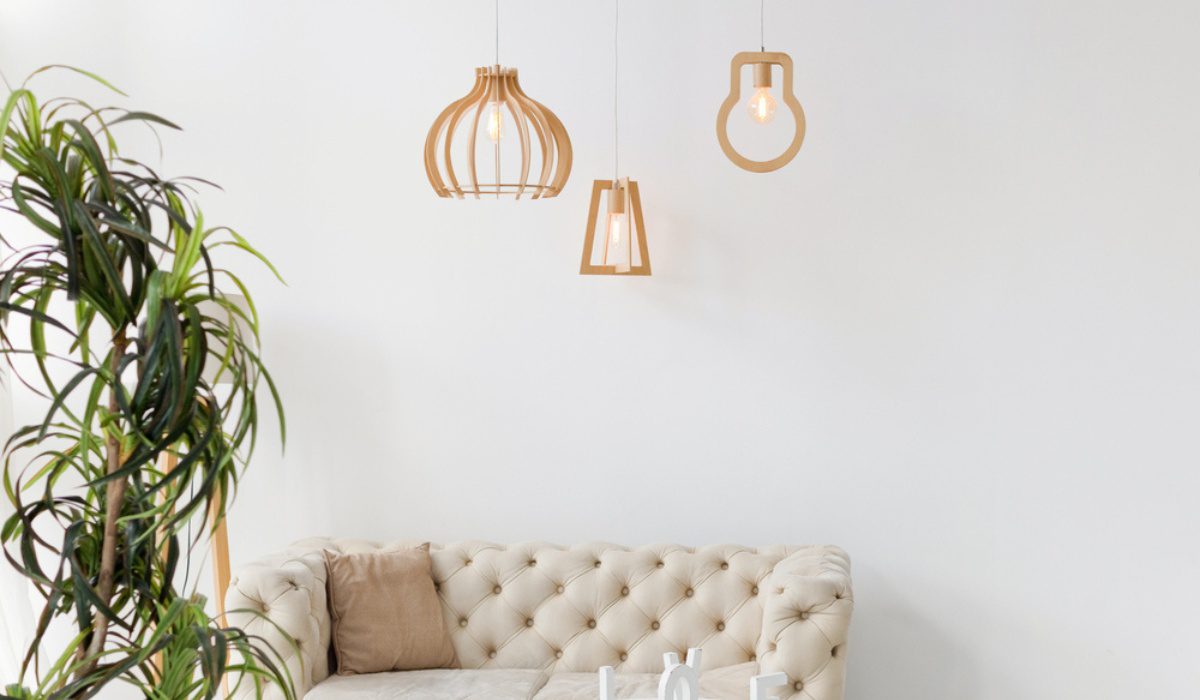As charming as they are, false ceilings are not everyone’s cup of tea. While some might find them a budgetary pressure, others may disapprove of them due to personal aesthetics. Whatever may be your reason for not wanting false ceilings, you do not have to make compromises to illuminate the living space. It is often projected that false ceilings are the best way to light up your home, however, it is a myth, which we bust in this guide by offering ceiling lighting options without any false ceiling installations.
Check these 10 common false ceiling design mistakes you should avoid
How bright should each room be?
When choosing ceiling lights without a false ceiling, it’s not just about the fixture style — brightness and beam spread matter just as much. The right lumen output (brightness) and beam angle ensure that every space feels balanced and functional.
- Living room: 150–300 lux (approx. 2,000–3,000 lumens total) for general ambience. Use wider beam angles (90°–120°) to spread light evenly.
- Kitchen/Task areas: 300–500 lux (approx. 3,500–4,500 lumens total). Narrower beam angles (40°–60°) work well over counters and islands for focused lighting.
- Bedroom: 100–200 lux (approx. 1,500–2,500 lumens total). Opt for soft, wide beams to avoid harshness and promote relaxation.
- Dining area: 150–250 lux (approx. 2,000–3,000 lumens). Pendants or cluster lights with mid-range beam angles (60°–90°) create a cozy, intimate setting.
- Bathroom/Vanity: 200–400 lux (approx. 2,000–3,000 lumens). Use a mix of overhead and mirror lighting, with focused beams around the vanity.
- Study/Home office: 300–500 lux (approx. 3,500–4,500 lumens). Use directional lights or task lamps with 30°–60° beams for concentration.
Mounted track lights with a twist

Source: Pinterest (1970393578452092)
Even though track lights are used to illuminate different areas of a room, a little twist can make them work as flush lights.
Suspended track lights

Source: Pinterest (14847873764955532)
Suspended track lights are a versatile lighting option that combines the flexibility of track lighting with the decorative appeal of pendant lights. These fixtures consist of a track system mounted to the ceiling from which adjustable pendant-style light fixtures are suspended.
Statement piece

Source: Pinterest/onekindesign
This is your classic chandelier with a modern twist. Lightweight and clean-cut, modern chandeliers are decorative ceiling-mounted light fixtures that feature multiple arms or tiers with light bulbs or candles. They add elegance and sophistication to dining rooms, foyers and other formal spaces.
Fairy lights

Source: Pinterest (1337074887443359)
One of the easiest methods to bring magic to a living space, fairy lights are a favourite illumination system, especially for bedrooms, living rooms or puja rooms. Fairly lights require very little time and monetary investment.
Semi flush mount lights

Source: Pinterest/estiluz
Similar to flush mount lights, semi-flush mount lights are attached to the ceiling, with a small gap between the fixture and the ceiling. This allows for airflow and slightly larger or more decorative fixtures.
Suspended wall lighting

Source: Pinterest (914862419582587)
Suspended wall lighting comes in a variety of designs, from minimalist and contemporary to ornate and traditional. These fixtures feature a pendant-style light that hangs down from a wall-mounted bracket or arm. The pendant can be made from glass, metal or fabric and may incorporate decorative elements, such as shades or diffusers.
Pendant lights

Source: Pinterest/lampsusa1
Pendant lights are suspended from the ceiling by a rod, chain or cord and hang freely in the room. They come in a wide range of styles, sizes and materials, making them suitable for various applications, such as task lighting over kitchen islands or decorative accents in living spaces.
LED pendant lighting

Source: Pinterest/Vakkerlight
Sleek and sassy, LED pendant lights are dimmable, allowing you to adjust the light intensity to create the desired atmosphere or accommodate different activities. Dimmable LED fixtures offer flexibility and control over the lighting environment.
LED wall lamps

Source: Pinterest/elvihomestore
This is the perfect choice for eco-sensitive homeowners who do not want elaborate installation work. LED bulbs have a longer lifespan than incandescent or fluorescent bulbs.
Wall scones

Source: Pinterest/aeyee_lighting
When it comes to functional illumination and decorative accents, nothing beats wall scones. The best part is that wall sconces come in a wide range of designs, from traditional to modern. They feature various materials, such as metal, glass, fabric or natural materials, such as wood or ceramic. This allows for flexibility in matching different décor themes and aesthetics.
Suspended Edison bulb lamp

Source: Pinterest/Metavaya
Crave a minimalistic style with some vintage appeal and an industrial twist? The Edison bulb lamp is for you. Edison bulbs, also known as filament bulbs or antique bulbs, have a distinctive appearance characterised by their exposed filament and warm-amber glow. Suspended Edison bulb lamps capitalise on this vintage aesthetic, creating a focal point that evokes a sense of nostalgia and old-world charm.
Ceiling-mounted spotlights
Ceiling-mounted spotlights offer focused illumination and can be directed toward specific zones like artworks, display units or reading corners. They are surface-mounted and ideal for spaces where recessed lighting isn’t possible.
Rope lighting on ceiling edges or mouldings
By installing LED rope lights along the perimeter of your ceiling or moulding, you can create a subtle glow that adds depth and dimension to the space. It’s a great way to mimic the layered lighting effect of false ceilings without the installation.
Swing arm wall lamps
Swing arm lamps can be mounted on walls and adjusted to direct light where it’s needed. They are practical for bedrooms or study areas and free up ceiling space while offering focused task lighting.
Cluster bulb pendants
Instead of one large pendant, you can hang a group of smaller bulbs at different heights to create a visual focal point. This trend works especially well in living rooms or dining areas and doesn’t need a false ceiling for impact.
Portable ceiling lamp hooks
If your ceiling can’t accommodate permanent fixtures, use plug-in pendant lights with ceiling hooks. These can be creatively positioned and adjusted to hang wherever needed, offering flexibility and easy installation.
Room-specific lighting suggestions
By offering room-specific lighting ideas, readers can make more informed decisions that best suit each area of their home.
Room-specific lighting suggestions
Living room:
- Track lighting: Ideal for highlighting artwork or specific areas, track lighting provides flexibility and can be adjusted to direct light where needed.
- Floor Lamps: These add both ambient and task lighting, perfect for reading nooks or seating areas.
Kitchen:
- Pendant lights: Hanging pendant lights over countertops or islands offer focused task lighting essential for cooking and food preparation.
- Under-Cabinet Lighting: Installing LED strips or puck lights under cabinets illuminates workspaces without the need for overhead fixtures.
Bedroom:
- Wall sconces: Mounted beside the bed, sconces provide reading light without occupying bedside table space.
- Table lamps: Versatile and decorative, table lamps offer soft, ambient lighting conducive to relaxation.
Bathroom:
- Vanity lighting: Fixtures placed above or beside mirrors ensure even illumination for grooming tasks.
- Recessed lighting: Suitable for general lighting, recessed fixtures can be strategically placed to avoid shadows.
Dining room:
- Chandeliers: A statement chandelier centered above the dining table adds elegance and ample light for meals.
- Buffet lamps: Placing lamps on a sideboard or buffet provides additional ambient lighting and enhances the room’s ambiance.
By incorporating these room-specific lighting ideas, the article can offer more targeted and practical advice, assisting readers in selecting the most appropriate lighting solutions for each area of their home.
Lighting options for rental homes (no drilling needed)
If you’re living in a rental apartment where drilling or structural changes aren’t allowed, there are still plenty of stylish and practical lighting options that don’t require a false ceiling—or even tools. These solutions are renter-friendly, removable, and won’t leave behind damage:
-
Plug-in pendant lamps with adhesive ceiling hooks: These fixtures can be suspended anywhere using peel-and-stick or screwless ceiling hooks, offering flexibility and zero commitment.
-
Rechargeable stick-on LED lights: Ideal for wardrobes, corners, or under cabinets, these battery-powered lights are motion-activated or touch-controlled and can be recharged via USB.
-
Clip-on reading lights for shelves and headboards: Perfect for bedrooms or study areas, these lights offer targeted illumination without needing installation.
-
Smart LED bulbs controlled via app: Replace existing bulbs with Wi-Fi-enabled smart LEDs to adjust brightness, color, and scheduling—without modifying switches or wiring.
These low-effort lighting hacks are ideal for renters who want functionality and ambience without compromising their security deposit or interior flexibility.
How to manage wiring for ceiling lights without a false ceiling?
One of the biggest challenges of installing ceiling lights without a false ceiling is dealing with visible wiring. However, with smart planning and modern accessories, you can keep the space looking clean and stylish:
- Use surface-mounted conduits in matching colors: These plastic or metal conduits can be fixed along ceiling or wall lines and painted to match your interior, making them discreet and functional.
- Choose decorative cable holders or raceways: Available in wood, brass, or matte black finishes, these raceways double as design elements while keeping wiring tidy.
- Reroute wiring creatively in older homes: Where rewiring is needed, use ceiling medallions to conceal junction points, run cables neatly along wall corners, or connect through external switchboards positioned for easy access.
- Keep safety in mind: Always use ISI-marked wiring accessories and ensure junction boxes are sealed and properly earthed to prevent fire or shock risks.
Lighting for low vs. high ceilings
Lighting plays a crucial role in defining the ambiance and functionality of a space, and the height of your ceilings significantly influences your lighting choices. Tailoring your lighting design to accommodate low or high ceilings ensures optimal illumination and enhances the room’s aesthetic appeal.
Lighting strategies for low ceilings
Low ceilings can make a room feel confined, but with thoughtful lighting, you can create an illusion of height and openness.
- Flush mount and semi-flush mount fixtures: These fixtures are installed close to the ceiling, providing ample light without occupying vertical space. They are ideal for areas with limited ceiling height.
- Recessed lighting: Also known as can lights or downlights, recessed fixtures are embedded into the ceiling, offering a sleek and unobtrusive lighting solution that doesn’t encroach on headroom.
- Track lighting: Mounted directly on the ceiling, track lighting systems allow adjustable light heads to be directed where needed, providing flexibility and a modern aesthetic.
- Wall sconces: By installing wall-mounted lights, you can free up ceiling space and add layers of illumination, enhancing the room’s depth and warmth.
- Uplighting: Floor lamps or sconces that direct light upwards can create the illusion of a higher ceiling by illuminating the upper walls and ceiling, adding a sense of verticality to the space.
Lighting strategies for high ceilings
High ceilings offer an opportunity to make a dramatic statement with your lighting choices, but they also require careful planning to ensure even illumination.
- Chandeliers: A grand chandelier can serve as a focal point, filling the vertical space and adding elegance to the room. Ensure the fixture is appropriately sized to complement the scale of the room.
- Pendant lighting: Hanging multiple pendant lights at varying heights can add visual interest and bring light closer to the living area, making the space feel more intimate.
- Recessed lighting with adjustable fixtures: Utilizing recessed lights with adjustable heads allows you to direct light to specific areas, ensuring adequate illumination throughout the space.
- Wall washers and sconces: Installing wall-mounted fixtures that direct light upwards or downwards can accentuate architectural features and provide balanced lighting.
- Ceiling fans with integrated lighting: Incorporating ceiling fans with built-in lights can be both functional and aesthetic, providing air circulation and illumination while complementing the room’s design.
Additional considerations
- Dimming controls: Installing dimmer switches allows you to adjust the light intensity according to the time of day and desired ambiance, providing flexibility and energy efficiency.
- layered lighting: Combining ambient, task, and accent lighting creates a balanced and versatile lighting scheme, enhancing both functionality and aesthetics.
- Color temperature: Selecting the appropriate color temperature for your light bulbs can influence the room’s mood. Warmer tones create a cozy atmosphere, while cooler tones offer a more energetic feel.
Dimming and control options for ceiling lighting
A well-lit room isn’t just about fixture choice — how you control brightness can make or break the experience. The wrong dimmer or driver pairing can cause flicker, humming, or even shorten fixture life. Here’s what to know when lighting without a false ceiling:
- TRIAC dimming (phase-cut): Common with most residential wall dimmers in India. Works well with many LED bulbs and retrofit fixtures but may not be compatible with all LED drivers. Always check “TRIAC compatible” on the packaging.
- 0–10V dimming: Popular in commercial and higher-end residential settings. Requires separate low-voltage control wiring and a compatible driver, but allows smoother dimming and better light consistency.
- Smart dimming (Wi-Fi / Zigbee / Bluetooth): Replace standard bulbs with smart LEDs or use smart dimmer switches. These allow app-based brightness control, scheduling, and voice commands without rewiring.
- DALI/DMX systems (advanced): Typically for large or premium projects. Offer granular control of zones and scenes but may be overkill for a compact home.
How to avoid harsh shadows when using surface lighting?
Without a false ceiling to diffuse light naturally, poor lighting placement can result in harsh shadows or uneven illumination. To achieve a well-lit and balanced environment, follow these practical tips:
- Use layered lighting: Relying on a single ceiling fixture can create dark corners and glare. Combine overhead lights with floor lamps, wall sconces, or table lamps to distribute light across multiple levels and eliminate shadows.
- Avoid placing directional spotlights directly above seating or workspaces: Overhead beams aimed straight down can cast unflattering shadows on faces or cause eye strain. Instead, angle spotlights toward walls or decor elements to create softer reflections.
- Choose diffused or frosted fixtures: Opt for lights with frosted glass, fabric shades, or built-in diffusers that scatter light gently rather than casting harsh beams. This ensures a more ambient, shadow-free glow throughout the room.
Strategic lighting placement plays a vital role in making any ceiling—false or not—feel inviting, functional, and glare-free.
Portable ceiling lamp hooks
Housing.com viewpoint
False ceilings are an individual choice based on personal design preferences. However, it is no precondition to jazz up your home on the lighting front. Rather than working towards a combination, opt for one of the above-mentioned modern ways of adding magical illumination to your home.
FAQs
What types of ceiling lights can be installed without a false ceiling?
Flush and semi-flush mount lights, pendant lights, track lights and recessed lights are some of the lights suitable for normal ceilings.
Can I use a pendant light without a false ceiling?
Yes, pendant lights can be used without a false ceiling. They are suspended from the ceiling by a rod, chain or cord.
Are there any limitations to installing ceiling lights without a false ceiling?
While you can install various types of ceiling lights without a false ceiling, it is important to consider the weight and size of the fixture and the height of the ceiling. You may have to adjust the wiring or mounting to accommodate the chosen fixture.
What are the benefits of installing ceiling lights without a false ceiling?
Installing ceiling lights without a false ceiling can be more cost-effective and less invasive. It allows for easier access to the wiring and junction box for maintenance and repairs.
What factors should be considered when installing a ceiling light without a false ceiling?
When installing a ceiling light without a false ceiling, consider factors, such as the room’s size, ceiling height, décor style and the intended lighting purpose. Ensure proper installation following the manufacturer’s instructions or seek assistance from a qualified electrician.
| Got any questions or point of view on our article? We would love to hear from you. Write to our Editor-in-Chief Jhumur Ghosh at jhumur.ghosh1@housing.com |







